|
Western Electric
Payphones and Phone Booths
Sewing Machine -
Automatic Answering Service
"Mirrophone" wire ribbon recorder/player
Telephones -
PicturePhone
- Bell Chime
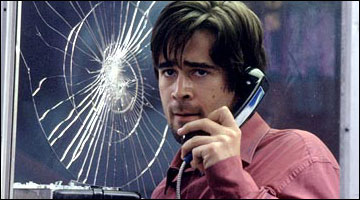
From the movie
Phone
Booth
Directed by Joel Schumacher
20th Century Fox
Contents:
Payphone Instruction and Information Display Cards
Bell System Practices sections on old phone
booths
Neat
website specializing in the history of the payphones of the world! - Link to
another website, not part of this website.
Schematics
For 1960's Western Electric manual and rotary
dial
Pay Phone schematics,
click here for figure 1 and
here for figure 24.
Western Electric 236G coin (pay) phone info
(courtesy of Dennis Owens):
Page 1 and
Page
2.

We Offer Personalized One-On-One
Service!
Call Us Today at (651) 787-DIAL (3425)


|
PAY
PHONE HISTORY TIMELINE |
-
In 1889, the first
public coin telephone was installed by inventor William Gray at a bank in
Hartford, Conn. It was a "postpay" machine (coins were deposited
after the call was placed). Gray's previous claim to fame was inventing
the inflatable chest protector for baseball.
-
In 1898, the Western Electric No. 5 Coin Collector, the first
automatic "prepay" station, went into use in Chicago. The
depositing of coins before placing a call would gradually become the norm
in pay phones until the introduction of "dial tone first"
service in 1966.
-
By 1902, there were 81,000 pay telephones in the United States.
-
In 1905, the first outdoor Bell System coin telephone was installed
on a Cincinnati street. It wasn't an instant hit; people apparently were
reluctant to make private calls on a public thoroughfare.
-
In the 1950s, glass outdoor telephone booths began replacing wooden
ones.
-
In 1957, "calling from your car" was first tested in
Mobile, Ala., and Chicago. Drive-up pay telephones proved popular and are
still in use today.
-
In 1960, the Bell System installed its millionth pay telephone.
Today there are 2.2 million pay phones, down from 2.6 million in 1998.
Local calls on pay phones also have dropped 30 percent since 1998.
-
In 1964, when the Treasury Department decided to change the
metallic composition of U.S. coins, it consulted with Bell Laboratories to
ensure the new coins would still function properly in pay phones.
-
In 1966, "dial tone first" service was introduced in
Hartford, Conn. This essentially turned coin phones into emergency call
stations because such calls could be made without first depositing coins.
-
On Feb. 2, 2001, BellSouth announced that it's getting out of the
pay phone business. That would make it the first major phone company to do
so.
Sources: American Public Communications Council and AT&T
|

Phone
Booth Advertisements
|
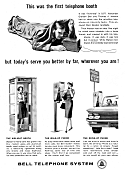
Phone Booth History Advertisement
Click to enlarge
(courtesy of Kermit Simon)
Click
HERE to see an unusual phone
booth made out of concrete! |
Click
HERE
to see an old advertisement by the Bell System for payphones.
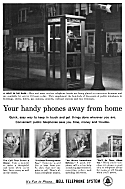
Scan of phone booth
advertisement |
And then came the breakup of the Bell System and anyone could
own a payphone. Here is an advertisement by AT&T for today's modern
payphone.
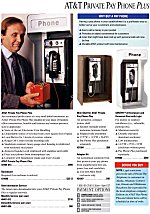
Click on image
above to enlarge
|

Avaya Plant Readies To Close
SHREVEPORT, La. (AP) -- The plant that once built the majority of U.S. pay telephones
will close on Sept. 30, putting 900 workers out of jobs, the plant's new owner, Avaya Inc.
(NYSE:AV - news), said Tuesday.
The plant is 35 years old and had been operated by Lucent Technologies, AT&T's consumer products division and Western Electric, which used the
plant to build pay phones. At one time, the plant had as many as 3,000 employees.
Avaya, based in Basking Ridge, N.J., took over the plant in October, when it was spun off from Lucent, and had been
manufacturing small business communication systems there.
The closure was part of a deal under which Avaya agreed to send most manufacturing of its communications systems as well as
some software to Toronto-based Celestica Inc. (NYSE:CLS - news) in a transaction valued at $4 billion over five years.
"This is an economic decision for the company, a very difficult one," said Avaya spokesman Kevin Stewart. "We know it's a very difficult time for our employees."
About 700 of the workers are unionized and are eligible for immediate retirement, the company said. Workers also can apply
for openings at other Avaya, Lucent and Celestica facilities, the company said.
Avaya's deal with Celestica is expected to close during the third quarter of 2001.

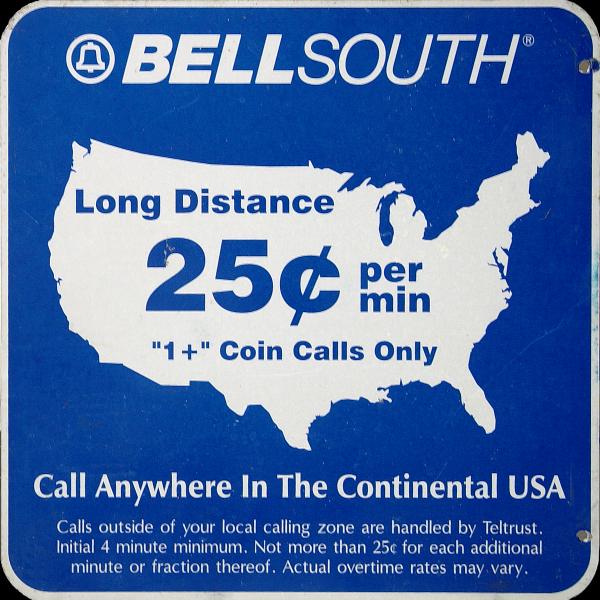
As call for pay
phones lessens,
BellSouth to cash in its stake
By
Michael E. Kanell
Atlanta
Journal-Constitution Staff Writer
The
Atlanta Journal-Constitution: February 3, 2001
When it comes to pay phones, BellSouth is hanging up.
The company has decided to put its 143,000 pay phones on the
block, selling them all during the next two years to exit a
faltering business that once was emblematic of Americans on the
move.
Once the only way to get in touch from airports, bus stations or
the road, the pay phone has become the poor, tethered cousin to tens
of millions of wireless devices. About 100 million people have
wireless phones, so they don't often reach for a coin phone. Pay
phone companies are looking for ways to get more out of their phones
- or to get out of the business.
In 1998, the country had 2.6 million phones, 400,000 more than
today. In that same period, BellSouth has shrunk its pay phone
inventory by nearly 24,000 phones in the Southeast.
BellSouth would be the first of the regional phone companies to
sell all its pay phones. But not the first to try. San Antonio-based
SBC Communications, for example, announced plans to sell but never
found a buyer.
And no one has sold off the pay phone business piecemeal, as
BellSouth means to do. The company declined comment on whether it
had already tried - and failed - to find a buyer.
"We explored a lot of things," said BellSouth spokesman David
Blumenthal. "That's all we can say."
The company wants to put its efforts into high-growth businesses
- high-speed data, wireless devices and Latin American
investments.
The company declined to provide details for current use or
profitability of its pay phones except to say that their usage has
"decreased dramatically." But just two years ago, industry estimates
put monthly revenues at $200 to $250 per phone. Today it may be less
than $150.
BellSouth, because it traditionally placed phones all over its
region and not just in the high-volume locations, may reap even less
money.
Like many people, Jacqui Chew doesn't miss the days of driving
down the road in search of that elusive phone booth.
"I remember in the early '90s, when I lived in Hawaii, my
roommate and I used to go down to the 7-Eleven to use the pay phone.
It was such a pain and you'd never have enough change," said Chew,
marketing director for Avienda Technologies. "Now today, I think
nothing of just dialing my friend in California on my cell
phone."
And it's not just wireless that hurts. Pay phone operators also
have trouble getting what they believe is full payment from
companies offering toll-free numbers and "dial-around" calling.
That can mean 30 to 35 percent lost revenue, said Vince Sandusky,
president of the American Public Communications Council. The
1,600-member trade group represents pay phone companies, except for
regional Bells like BellSouth. Third-largest is Atlanta-based ETS,
which has about 40,000 pay phones. Compared to the Bells, the
independents are niche players in a shrinking market.
"There's really no question that this has become a very tough
business," Sandusky said.
Tough, but not impossible, he said. After all, there are times
that a wireless phone user is too far from a cell tower to make a
call. Or has a dying battery. Or maybe fears having a delicate
conversation plucked from the air.
Besides, there are about 6 million Americans who don't have any
kind of phone, he said. "Add it up and there's still a business
there."
And some people would prefer a landline connection for their
laptop - something that more pay phone operators are offering as
they try to retool for the new technologies.
Jeff Kagan, Atlanta-based telecommunications analyst, said pay
phones will survive - at least for a time - by changing.
"The future pay phone will have keyboards and touch screens and
will let people access their e-mail and voice mail boxes and access
other Web-based information," he said. "That will give the pay phone
business a few more years of viability, but ultimately, devices that
make calls and send e-mail will be cheap enough for everyone to
carry one."
Side note: Steve Schack (ATCA
member #567 and Qwest Smart payphone DB administrator) sent me an
Excel spreadsheet file showing locations of some of the BellSouth payphones that
still
existed in the Atlanta, Georgia area in early 2003. Click
HERE to download or open this
file.

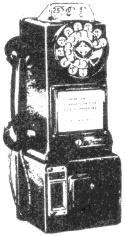 |
It is difficult to find
information on pay telephones or coin phones as they use to be called. However, I found an
excellent and interesting historical summary about the history of pay phones on AT&T's
web site. The text from the AT&T web page is shown
below. |

For photos of pay phones from around the world,
go to this neat web site:
The Pay Phone
Project.

Photos of Bob's
Antique Telephones
Phone: 1-260-351-4792
E-mail: [email protected]

From a link on the AT&T web site http://www.att.com/press/1091/911002.csa.html
"Pay telephone stations preceded the
invention of the pay phone and existed as early as 1878. These stations were supervised by
telephone company attendants or agents (such as an employee in a hotel where a station
might be located) who collected the money due after people made their calls. Some pay
stations utilized a fail-safe collection method: After making the connections for
customers, attendants would lock them in booths so they couldn't leave without paying.
In 1889, the first public coin telephone was
installed by inventor William Gray at a bank in Hartford, Conn. It was a
"postpay" machine (coins were deposited after the call was placed). Gray's
previous claim to fame was inventing the inflatable chest protector for baseball.
In 1898, the Western Electric No. 5 Coin
Collector, the first automatic "prepay" station, went into use in Chicago. The
depositing of coins before placing a call would gradually become the norm in pay phones
until the introduction of "dial tone first" service in 1966.
By 1902, there were 81,000 pay telephones in
the United States.
In 1905, the first outdoor Bell System coin
telephone was installed on a Cincinnati street. It wasn't an instant hit; people
apparently were reluctant to make private calls on a public thoroughfare. (Moose were not
as shy when they first encountered outdoor pay phones. When Bell Laboratories designed a
new glass and aluminum outdoor telephone booth in the 1950s, it was a great advancement
over the wooden outdoor booths that had been in use for a number of years. And yet several
booths ordered by the U.S. National Park Service were found mysteriously broken and
battered. Park rangers soon knew the answer, though: It was mating season for moose.
Amorous--but territorial--bulls were charging the booths whenever they saw their
reflections in the glass.)
In 1910, Western Electric and Gray Telephone
Pay Station Co. signed an agreement for Gray to manufacture coin collectors for the Bell
System using both Gray and Western Electric patents.
The result of that agreement, the 50A coin
collector, went into production in 1911. By the end of 1912, 25,000 of these coin
telephones had been ordered for New York City alone. The 50A model had three coin
slots--for nickels, dimes and quarters --and was a "prepay" machine. The basic
design, though often modified, was so practical and reliable it remained in production
until 1964. In 1965, Western Electric introduced the 50A's successor. Among other things,
it had a single coin slot instead of three, and electronic signalling of coins deposited
replaced mechanical bells.
The booths that house pay phones have
undergone more design changes than the phones themselves. At the turn of the century,
indoor booths were constructed of durable hardwood, such as mahogany, with comfort and
privacy in mind, and exhibited detailed craftsmanship. They were often carpeted. The
"original" telephone booth is credited to Thomas Watson, the man who helped
Alexander Graham Bell invent the telephone. Watson's "booth" was made by draping
blankets over the furniture in his room and crawling underneath to conduct early telephone
experiments. One story says Watson, in order to hear, was insulating himself from street
noises. Another story is that his landlady ordered Watson to be quieter; his shouting,
albeit for the sake of science, was disturbing other boarders. In 1883 Watson designed a
real booth. It was built of expensive wood, had a domed top with a ventilator, windows
with screens, and a desk with pen and ink. Over the years, telephone booths have reflected
their surroundings as well as the times. There have been phone booths resembling cable
cars in San Francisco, and others resembling pagodas in New York City's Chinatown
district. In the 1960s, as American architects designed glass-wall office buildings,
wooden phone booths looked out of place in lobbies. Bell Laboratories designed an indoor
glass and metal phone booth to better fit newer surroundings. Not all of the designs for
phone booths have reached the market. An experimental "hands-free" booth in 1972
featured a microphone in front of the caller and a loudspeaker in the booth's ceiling.
Observers noted that people readily tried the new arrangement but that, conditioned to
speaking in the direction another voice is coming from, they were all shouting into the
ceiling.
In 1950, the first coin telephone mobile train
service was established on the Pennsylvania Railroad between New York and Washington.
"Calling from your car" was first
tested in Mobile Ala., and Chicago in 1957. Drive-up pay telephones proved popular and are
still in use today.
In 1960, the Bell System installed its one
millionth pay telephone.
In 1964, when the U.S. Treasury Department
decided to change the metallic composition of U.S. coins, it consulted with Bell
Laboratories to ensure the new coins would still function properly in pay phones.
"Dial tone first" service was
introduced in 1966 in Hartford, Conn. This essentially turned coin phones into emergency
call stations because such calls could be made without first depositing coins.
In 1977, "automatic coin telephone
service" was introduced in Phoenix, Ariz. This allowed most pay telephone calls,
including long-distance, to be made without operator assistance. A computer-controlled
synthesized voice gave customers the necessary instructions.
AT&T introduced "Charge-a-Call,"
a "coinless" pay phone, in 1978 (and the term "pay phone" began to
replace "coin phone").
In 1984, AT&T introduced the AT&T Card
Caller, which featured a video screen with dialing instructions and allowed customers to
charge calls by inserting an AT&T Calling Card. The Card Caller also was the first of
AT&T's public phones to feature a "loud" button, which allows callers to
control the listening volume. It helps the hearing-impaired as well as those having a hard
time hearing because of environmental noise.
In 1990, AT&T introduced the AT&T
Public Phone 1000, which features a data port for laptop computer and portable fax use,
speed dialing for select AT&T services and travelers assistance. This tabletop phone
was designed primarily for airline lounges and hotels.
The latest advance in pay phone technology is
the AT&T Public Phone 2000. Introduced in the fall of 1991, the Public Phone 2000 has
a built-in keyboard, a data port and a nine-inch color monitor. Besides offering all the
traditional voice services, it enables travelers to use an array of services never before
available from a pay phone. Public Phone 2000 users can access electronic mail and online
databases, connect a portable fax machine or computer, obtain language translation
services, speed-dial travel assistance services and even get weather forecasts."
Copyright © 1997 AT&T. All rights
reserved.

Links:
Pay Phone Directory
PayPhone Project

Man Separated from Payphone at Hospital
On November 17, 2003 in East St. Louis, Illinois, a guy
named Fleming was trying to call his wife from a payphone but the line was
busy. As we all know, the payphone is suppose to return your coins if the line
is busy or nobody answers the phone at the other end. Well, this guy got his
middle finger stuck in the coin return while trying to retrieve his refunded
money. Two people that happened to pass by tried to help him free his finger
from the payphone but failed. Fleming then used his other hand to dial
911 for help.
According to the Associated Press news story of November 18, 2003, the
emergency crews were unable to free him from the phone so they proceeded to
cut the payphone off at the base and hauled the payphone, with Fleming still
attached to the payphone, to the hospital.
It took three hours at the hospital before they were able to separate Fleming
from the payphone. The manager of the ambulance company said he has seen some
weird things in his 30 years of working emergencies but never before had he
seen a person stuck in a payphone.
I wonder if he got his fifty cents back from that
payphone after they got his finger out of the coin return?
Famous people seen with payphones:
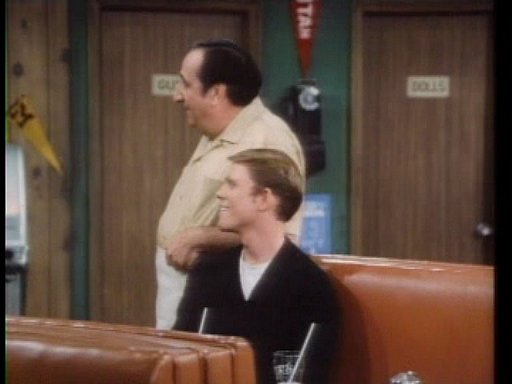
A Western Electric 3-slotter pay phone (on wall
between restroom doors)
was used in Al's Diner on the TV show "Happy Days"
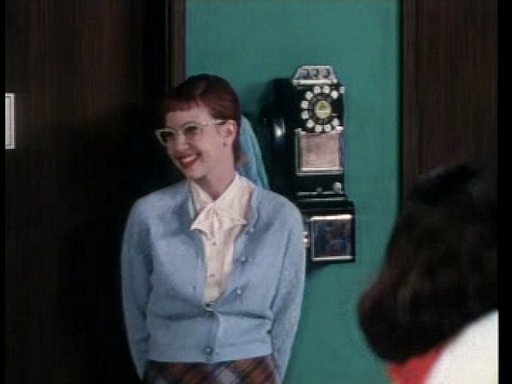
The 1950's look: A teenage girl standing next
to a
Western
Electric
pay telephone in the "Happy Days" TV show!
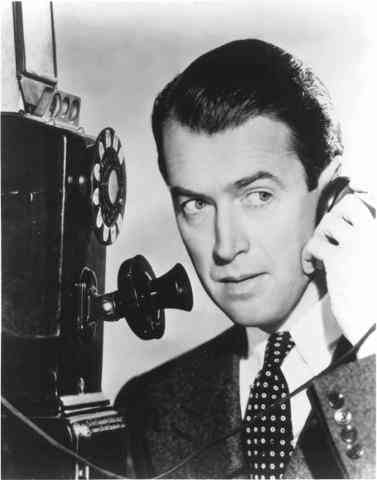
Guess who this famous person is? Hint:
"It's A Wonderful Life".
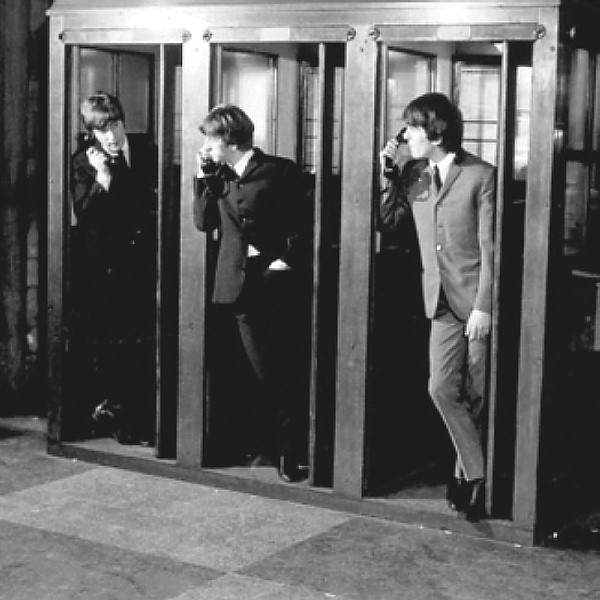
Could these guys be the Beatles in those phone booths?
And just some ordinary
people with payphones:
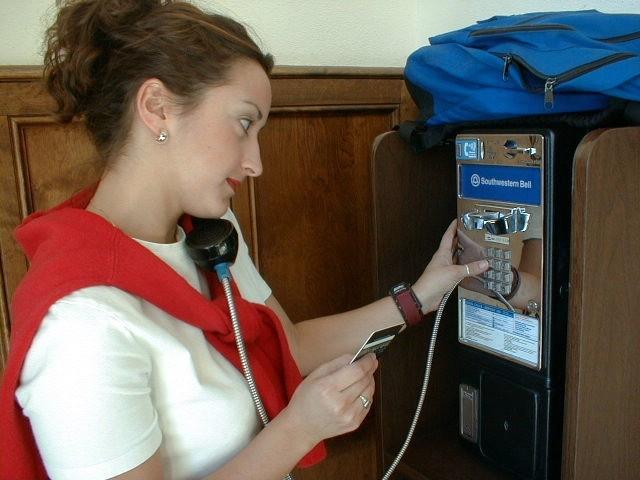
Modern day girl on modern payphone using
calling card instead of coins.
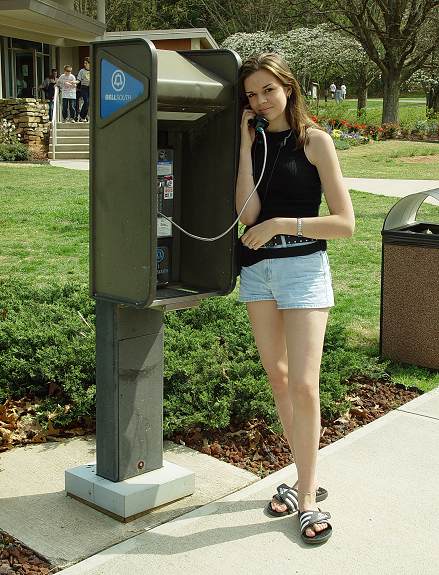
April 2002 - Payphone at
Kennesaw Mountain
National Battlefield Park near where I live.
A close-up front view of this payphone can be viewed by clicking
HERE.
Note BellSouth logo on left side of
booth partition and on vault door.
Booth is painted "forest green" to make it blend in with the natural
environment of the park.
The phone number of this payphone is 770-428-9258 in the USA.
One year
later, April 2003
UPDATE!!
Well, as expected,
BellSouth is serious about
getting out of the payphone business.
I went back to this location April of 2003 and the phone was gone!
See updated photo below:

To view the inside of this now empty and
lonely phone booth showing
the mounting plate where the phone use to be attached, click
HERE. Click
HERE to see another photo of this
empty phone booth at full size.
This is a sad situation indeed. A piece of telephone history will soon
be no more than a memory and millions of dollars worth of pay
phones and phone booths will be sold for scrap!
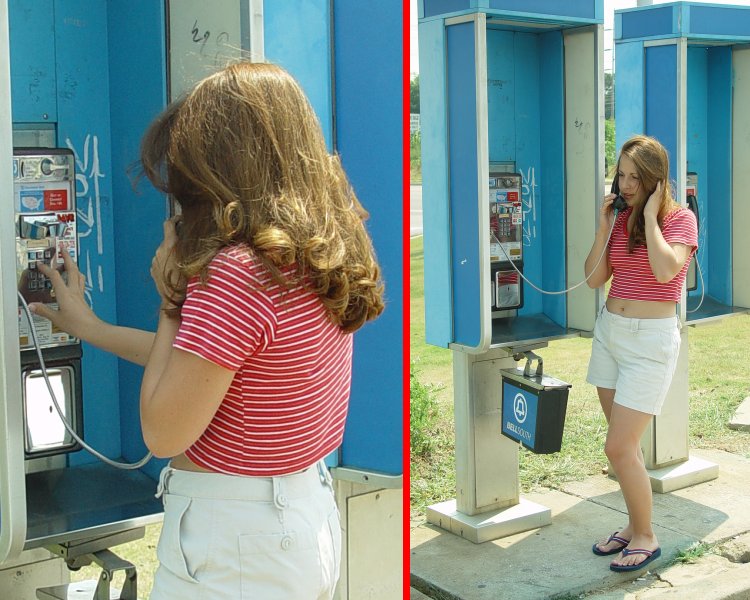
These phone booths are located at the BP
gasoline station at the
intersection of Cobb Parkway
(Hwy. 41) and Bells Ferry
Road in Marietta,
Georgia,
USA which is in BellSouth's service area.
However, the phone itself has a
Cincinnati Bell identification card
but the
phone book's
protective cover (seen hanging down from the phone booth
in photo
above)
says BellSouth
and there is
no company name or logo on the top part of the phone booth where
you would
normally
find some sort of logo and
name. There is no telling what phone company this
unidentified girl
was
using when she
placed her call.
Just a few steps away from the
phone booths at the BP station shown above is a real BellSouth phone booth at
the
McDonald's restaurant. It is in need of repair at seen in the photo below
but it is interesting that McDonald's has their
name and logo on the sides of the booth.
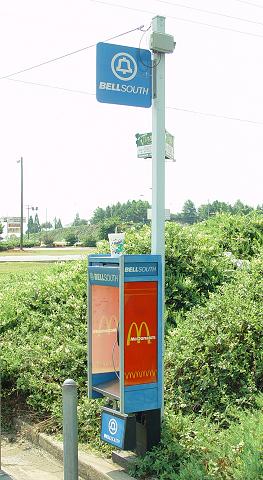
Clicking on the sign on the top of the pole, or
the middle of the booth, or the
top of the booth in the photo above will enlarge those areas for better viewing.

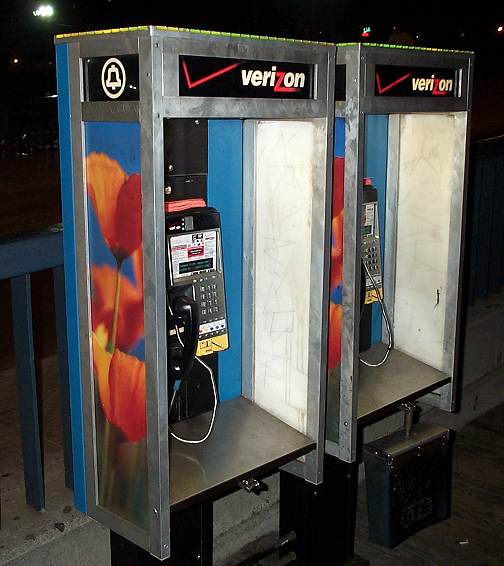
Photo taken by and sent to by anonymous donor.

The following photos were sent by a retired
manager from Verizon named Tim Coe. His last assignment (which lasted 10 years) was in
the Public Telephone Installation Maintenance Center (essentially the payphone
service center.) His responsibilities were Results/Analysis of of service related indices along with
oversight responsibility of outside contractors who installed booths/enclosures.

"Bell System" Phone Booths spotted
at Yellowstone National Park!

View outside the "General Store" |

Photo #1 of Phone Booths |
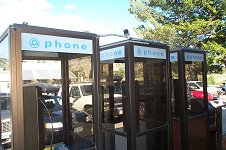
Photo #2 of Phone Booths |

Close-up photo of Bell System
logo on lighted sign of phone booth |
Click on images above to view full-size
"Over the July 4 [2003] holiday, I visited
Yellowstone National Park. At Historic Fort Yellowstone outside the general
store, there are 3 booths with US West signs on the front but vintage signs on
the back." - Contributor of these photos asked to remain anonymous.

You'll find lots of payphone photos from
around the world at:
http://www.payphone-project.com/payphones/photos/
t h e p a y p h o n e p r o j e c
t
This compilation copyright 1995-2002, Mark Thomas. All rights reserved
worldwide.
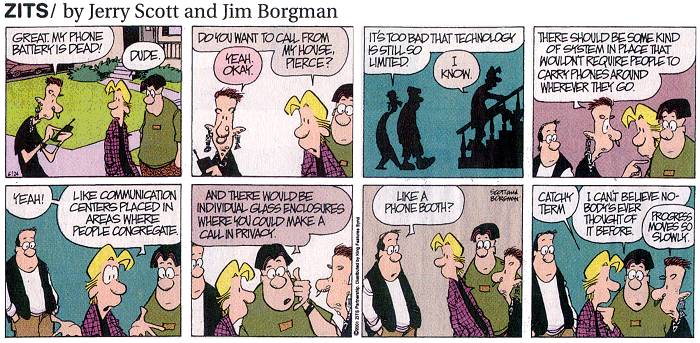

Source unknown


Payphone
instruction and
information display cards
No payphone is complete without those
cards that go in the framed "windows" on the front and (in the case of the old
3-slot phones) the top. You can buy
them or make some yourself from high-quality scans of original cards.
We have scanned some of the original cards we have and posted
them on this website for anyone that wishes to make their own cards for their
payphone collection. Just download the following high resolution image
files by selecting the thumbnail image then import the images into a word
processor program like Microsoft Word or OpenOffice.org so you can print them
easily:

Here are some
Bell System Practices sections on old phone
booths - courtesy of
Sam Etler:

Gray Manufacturing Company Stock
Certificate - (Nice scan by Paul Rauth who bought
the original certificate.) Has Gray pay station image on it.

|

